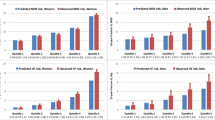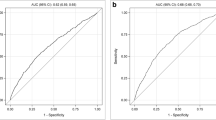Abstract
Summary
We evaluated performance of FRAX in older men who participated in the Osteoporotic Fractures in Men (MrOS) study.
Introduction
FRAX has been extensively studied in women, but there are few studies of its performance in men.
Methods
FRAX estimates for 10-year hip fracture and major osteoporotic fracture (MOF; either hip, clinical spine, forearm, or shoulder) were calculated from data obtained from MrOS participants and compared to observed 10-year fracture cumulative incidence calculated using product limit estimate methods, accounting for competing mortality risk.
Results
Five thousand eight hundred ninety-one men were followed for an average of 8.4 years. Without bone mineral density (BMD) in the FRAX model, the mean 10-year predicted fracture probabilities for hip and MOF were 3.5 % and 8.9 %, respectively; addition of BMD to the calculations reduced these estimates to 2.3 % and 7.6 %. Using FRAX without BMD, predicted quintile probabilities closely estimated cumulative incidence of hip fracture (range of observed to predicted ratios 0.9–1.1). However, with BMD in the FRAX calculation, observed to predicted hip fracture probabilities were not close to unity and varied markedly across quintiles of predicted probability. For MOF, FRAX without BMD overestimated observed cumulative incidence (range of observed to predicted ratios 0.7–0.9) and addition of BMD did not improve this discrepancy (range of observed to predicted ratios 0.7–1.1). Addition of BMD to the calculation had mixed effects on the discriminatory performance of FRAX, depending on the analysis tool applied.
Conclusion
Among this cohort of community-dwelling older men, the FRAX risk calculator without BMD was well calibrated to hip fracture but less well to MOF.


Similar content being viewed by others
References
FRAX. www.shef/ac/uk/FRAX/ Accessed April 30, 2012.
Kanis JA, Oden A, Johnell O, Johansson H, De Laet C, Brown J, Burckhardt P, Cooper C, Christiansen C, Cummings S, Eisman JA, Fujiwara S, Glüer C, Goltzman D, Hans D, Krieg MA, La Croix A, McCloskey E, Mellstrom D, Melton LJ 3rd, Pols H, Reeve J, Sanders K, Schott AM, Silman A, Torgerson D, van Staa T, Watts NB, Yoshimura N (2007) The use of clinical risk factors enhances the performance of BMD in the prediction of hip and osteoporotic fractures in men and women. Osteoporos Int 18(8):1033–1046
Dawson-Hughes B (2008) A revised clinician's guide to the prevention and treatment of osteoporosis. J Clin Endocrinol Metab 93(7):2463–2465
www.sheffield.ac.uk/NOGG/downloads.html. Osteoporosis—clinical guideline for prevention and treatment. Executive Summary, Updated July 2010. National Osteoporosis Guideline Group (NOGG) on behalf of the Bone Research Society, British Geriatrics Society, British Orthopaedic Association, British Society of Rheumatology, National Osteoporosis Society, Osteoporosis 2000, Osteoporosis Dorset, Primary Care Rheumatology Society, Royal College of Physicians and Society for Endocrinology; accessed April 30, 2012
www.WHO-FRAX.org; accessed April 30, 2012
Yun H, Delzell E, Ensrud KE, Kilgore ML, Becker D, Morrisey MA, Curtis JR (2010) Predicting hip and major osteoporotic fractures using administrative data. Intern Med 170:1940–1941
Leslie WD, Lix LM, Johansson H, Oden A, McCloskey E, Kanis JA, Program MBD (2010) Independent clinical validation of a Canadian FRAX tool: fracture prediction and model calibration. J Bone Miner Res 25(11):2350–2358
Ettinger B, Liu H, Blackwell T, Hoffman AR, Ensrud KE, Orwoll ES, for the Osteoporotic Fracture in Men (MrOS) Research Group. (2012)Validation of FRC, a fracture risk assessment tool, in a cohort of older men: the Osteoporotic Fracture in Men (MrOS) Study. J Clin Densitom 15(3):334–342
Orwoll E, Blank JB, Barrett-Connor E, Cauley J, Cummings S, Ensrud K, Lewis C, Cawthon PM, Marcus R, Marshall LM, McGowan J, Phipps K, Sherman S, Stefanick ML, Stone K (2005) Design and baseline characteristics of the osteoporotic fractures in men (MrOS) study—a large observational study of the determinants of fracture in older men. Contemp Clin Trials 26(5):569–585
Blank JB, Cawthon PM, Carrion-Petersen ML, Harper L, Johnson JP, Mitson E, Delay RR (2005) Overview of recruitment for the osteoporotic fractures in men study (MrOS). Contemp Clin Trials 26:557–568
Looker AC, Wahner HW, Dunn WL, Calvo MS, Harris TB, Heyse SP, Johnston CC Jr, Lindsay R (1998) Updated data on proximal femur bone mineral levels of US adults. Osteoporos Int 8(5):468–489
Pahor M, Chrischilles EA, Guralnik JM, Brown SL, Wallace RB, Carbonin P (1994) Drug data coding and analysis in epidemiologic studies. Eur J Epidemiol 10(4):405–411
Tosteson AN, Melton LJ III, Dawson-Hughes B, Baim S, Favus MJ, Khosla S, Lindsay RL, National Osteoporosis Foundation Guide Committee (2008) Cost-effective osteoporosis treatment thresholds: the United States perspective. Osteoporos Int 19(4):437–447
Pencina MJ, D'Agostino RB Sr, Steyerberg EW (2011) Extensions of net reclassification improvement calculations to measure usefulness of new biomarkers. Stat Med 30(1):11–21
Cook NR, Ridker PM (2009) Advances in measuring the effect of individual predictors of cardiovascular risk: the role of reclassification measures. Ann Intern Med 150(11):795–802
Pencina MJ, D'Agostino RB Sr, D'Agostino RB Jr, Vasan RS (2008) Evaluating the added predictive ability of a new marker: from area under the ROC curve to reclassification and beyond. Stat Med 27(2):157–172
Ettinger B, Black DM, Dawson-Hughes B, Pressman AR, Melton LJ 3rd (2010) Updated fracture incidence rates for the US version of FRAX. Osteoporos Int 21(1):25–33
Cook NR (2007) Use and misuse of the receiver operating characteristic curve in risk prediction. Circulation 115(7):928–935
Kanis JA, Oden A, Johansson H, McCloskey E (2012) Pitfalls in the external validation of FRAX. Osteoporos Int 23:423–431
Schwartz AV, Vittinghoff E, Bauer DC, Hillier TA, Strotmeyer ES, Ensrud KE, Donaldson MG, Cauley JA, Harris TB, Koster A, Womack CR, Palermo L, Black DM, Study of Osteoporotic Fractures (SOF) Research Group, Osteoporotic Fractures in Men (MrOS) Research Group, Health, Aging, and Body Composition (Health ABC) Research Group (2011) Association of BMD and FRAX score with risk of fracture in older adults with type 2 diabetes. JAMA 305(21):2184–2192
Donaldson MG, Cawthon PM, Schousboe JT, Ensrud KE, Lui LY, Cauley JA, Hillier TA, Taylor BC, Hochberg MC, Bauer DC, Cummings SR, Study of Osteoporotic Fractures (SOF) (2011) Novel methods to evaluate fracture risk models. J Bone Miner Res 26(8):1767–1773
Pressman AR, Lo JC, Chandra M, Ettinger B (2011) Methods for assessing fracture risk prediction models: experience with FRAX in a large integrated healthcare delivery system. J Clin Densitometry 14(4):407–415
Adler RA, Hastings FW, Petkov VI (2010) Treatment thresholds for osteoporosis in men on androgen deprivation therapy: T-score versus FRAX. Osteoporos Int 21:647–653
Mackey DC, Lui LY, Cawthon PM, Bauer DC, Nevitt MC, Cauley JA, Hillier TA, Lewis CE, Barrett-Connor E, Cummings SR, Study of Osteoporotic Fractures (SOF) and Osteoporotic Fractures in Men Study (MrOS) Research Groups (2007) High-trauma fractures and low bone mineral density in older women and men. JAMA 298(20):2381–2388
Acknowledgments
The Osteoporotic Fractures in Men (MrOS) study is supported by National Institutes of Health funding. The following institutes provide support: the National Institute of Arthritis and Musculoskeletal and Skin Diseases (NIAMS), the National Institute on Aging (NIA), the National Center for Research Resources (NCRR), and NIH Roadmap for Medical Research under the following grant numbers: U01 AR45580, U01 AR45614, U01 AR45632, U01 AR45647, U01 AR45654, U01 AR45583, U01 AG18197, U01-AG027810, and UL1 RR024140. Dr. Curtis receives support from National Institutes of Health AR053351.
Conflicts of interest
With the exception of Dr. Ettinger, none of the other co-authors report potential conflicts of interest. Dr. Ettinger has received consulting fees from Foundation for Osteoporosis Research and Education (FORE) and currently serves on their Medical Science Advisory Board.
Author information
Authors and Affiliations
Consortia
Corresponding author
Rights and permissions
About this article
Cite this article
Ettinger, B., Ensrud, K.E., Blackwell, T. et al. Performance of FRAX in a cohort of community-dwelling, ambulatory older men: the Osteoporotic Fractures in Men (MrOS) study. Osteoporos Int 24, 1185–1193 (2013). https://doi.org/10.1007/s00198-012-2215-3
Received:
Accepted:
Published:
Issue Date:
DOI: https://doi.org/10.1007/s00198-012-2215-3




